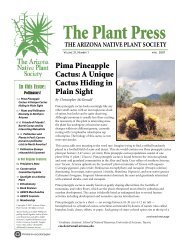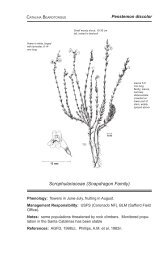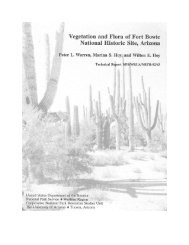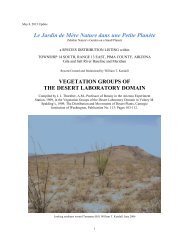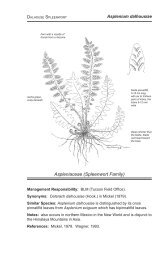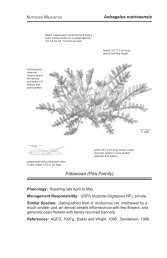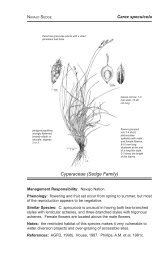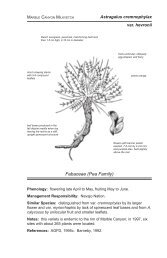iparian areas; sandy waste places; recently burned areas of scrub, and disturbed areas growing in wet, moist, damp and drydesert pavement; bouldery, bouldery-rocky, rocky, rocky-pebbly, rocky-sandy, shaley, stony, stony-gravelly, cindery, gravelly,gravelly-sandy and sandy ground; rocky loam, rocky-clayey loam, cobbly-sandy loam, sandy loam, clayey loam, silty loam andloam ground; rocky-sandy clay, rocky clay, gravelly clay, sandy clay and clay ground, and rocky silty, rocky-clayey silty,gravelly silty, sandy silty and silty ground, occurring from sea level to 8,000 feet in elevation in the forest, woodland, scrub,grassland, desertscrub and wetland ecological formations. NOTES: EXOTIC Invasive <strong>Plant</strong> which poses a significant threat toour native biotic communities. Bromus rubens is native to southern Europe; middle and western Asia, and northern Africa. *5, 6,15, 16, 22 (color photograph), 33 (Page 50), 43 (100309 - no record for Bromus madritensis subsp. rubens), 44 (032711 - speciesrecords located under Bromus madritensis L. subsp. rubens (L.) Husn; genus record), 46 (Page 78), 56, 57, 58, 63 (100409 - colorpresentation), 68, 77, 80 (The Ergot Fungus (Claviceps sp.) is listed as a Secondary Poisonous Range <strong>Plant</strong>. Species of the genusBromus can be hosts of the Ergot Fungus. “Ergot contains poisonous alkaloids and other compounds that may cause chronicpoisoning (gangrenous ergotism) in the extremities when consumed in small amounts, or convulsive poisoning when largeamounts are eaten. Animals may be poisoned by feeding on mature, infected grain or hay. Livestock, especially cattle, andhumans are susceptible. ... Pastures causing ergot poisoning should be mowed or the animals removed. Mildly poisoned animalswill usually recover if removed from the infested pastures, kept quiet, and supplied with good feed and water. In <strong>Arizona</strong>, somelosses may be expected on rangelands during wet years, but most losses have occurred from grazing pastures of Dallas Grass(Paspalum dilatatum).” See text for additional information.), 85 (102611 - color presentation), 89 (reported under MiscellaneousIntroduced Species as being a winter annual herb), 105, 124 (032711 - no record of species; genus record), 140 (Pages 201, 202,214 & 299)*Bromus tectorum C. Linnaeus: CheatgrassSYNONYMY: Bromus tectorum C. Linnaeus var. glabratus F.C. Spenner; Bromus tectorum C. Linnaeus var.tectorum. COMMON NAMES: Awned Brome Grass (Iowa); Brome des Toits (French); Brome Grass (a name also applied tothe genus Bromus); Brom Tec; Brom Tect; Bromo (a name also applied o the genus Bromus); Bromo Velloso (Spanish); Bromofelpudo(Portuguese: Brazil); Bromo-pendente (Portuguese: Brazil); Bronco Grass (a name also applied to other species);Broncograss (a name also applied to other species); Capim-cevadinha (Portuguese: Brazil); Cheat Brome; Cheat Grass (a namealso applied to other species); Cheatgrass (a name also applied to other species); Cheatgrass Brome; Cheatgrass Brome; CommonCheat; Common Cheatgrass; Dachtrespe (German); Downy Brome (a name also applied to other species); Downy Brome Grass;Downy Brome-grass; Downy Bromegrass; Downy Cheat; Downy Cheat Grass; Downy Cheat-grass; Downy Cheatgrass; DownyChess; Downy Chess Brome; Downy Chess Brome Grass; Downy Chess Bromegrass; Drooping Brome; Drooping Brome-grass;Drooping Bromegrass; Early Chess; Espiguilla Colgante (Spanish); Festuca avenacea sterilis humilior (Bauhin 1622); EuropeanCheat Grass; European Cheat-grass; European Cheatgrass; Gramen Avencaeum Locustis Villosis Angustis Canticantibus etAristis (Tournefort 1694); Fire Prone Cheatgrass; Fire-prone Cheat Grass; Fire-prone Cheatgrass; Introduced Cheat; IntroducedCheat Grass; Introduced Cheatgrass; Invasive Cheat Grass; Invasive Cheat-grass; Invasive Cheatgrass; June Grass (a name alsoapplied to other species); Military Grass (Montana); Mormon Oats; Nonnative Cheatgrass; Slender Chess (Indiana); Soft Chess (aname also applied to other species); Taklosta (Swedish); Thatch Bromegrass; Weedy Cheat Grass; Weedy Cheat-grass; WeedyCheatgrass; Wild Oats (a name also applied to other species and the genus Bromus); 100-Days Grass. DESCRIPTION:Terrestrial annual tufted graminoid (decumbent, geniculate, ascending and/or erect culms 1 inch to 3 feet in height); the foliage islight green aging to purple or purple-green at maturity and curing to a straw-yellow; spikelets (flowers) may be purplish-tinged;flowering generally takes place between mid-March and late August (additional records: one for late January, two for mid-September, two for late September and two for mid-October). HABITAT: Within the range of this species it has been reportedfrom mountains; rocky mountaintops; gravelly-loamy mountainsides; rocky-sandy, shaley-clayey, gravelly-sandy, gravellyloamy,sandy and sandy-loamy mesas; sandy plateaus; rocky, shaley and clayey-loamy cliffs; cracks in cliffs; hanging gardens;bases of cliffs; rocky canyon rims; along shaley-clayey, gravelly and sandy canyons; along pebbly-sandy canyon walls; sandyand clayey canyon bottoms; rock slides; talus slopes; crevices in rocks; rocky, stony-cobbly, gravelly and chalky bluffs; rocky,rocky-gravelly-clayey, cindery (scoria), gravelly-sandy, sandy-clayey, sandy-silty-clayey and clayey buttes; knobs; rocky-sandyloamy,stony and sandy knolls; rocky, rocky-gravelly-silty and sandy ledges; rocky, rocky-shaley, rocky-sandy, shaley, stony,cindery (scoria), gravelly, gravelly-sandy, sandy and sandy-clayey ridges; rocky, sandy and clayey ridgetops; bases of ridges;rocky clearings in forests and woodlands; along rocky, gravelly-loamy, sandy and clayey meadows; rocky foothills; bouldery,bouldery-gravelly, rocky, stony, stony-cobbly-clayey, shaley, gravelly, sandy, loamy, clayey and chalky hills; cindery (scoria)and clayey hilltops; rocky, rocky-sandy-loamy, sandy and clayey hillsides; pediments; bedrock, bouldery, bouldery-gravelly,rocky, rocky-gravelly, rocky-gravelly-sandy, rocky-sandy, rocky-sandy-clayey, rocky-loamy, rocky-clayey, rocky-powdery,shaley, shaley-gravelly, shaley-sandy, shaley-clayey, stony, stony-cobbly, stony-cobbly-gravelly, stony-gravelly, stony-sandy,stony-sandy-clayey, cobbly-sandy-loamy, cobbly-loamy, cindery, gravelly, gravelly-sandy, gravelly-sandy-loamy, gravellyloamy,gravelly-clayey-loamy, gravelly-silty-loamy, pebbly, sandy, sandy-loamy, sandy-clayey, sandy-clayey-loamy, sandy-silty,loamy, clayey, clayey-silty and silty-clayey slopes; gravelly-sandy bases of slopes; alluvial fans; rocky and shaley outcrops;sandy bases of outcrops; amongst boulders and rocks; bases of clinkers; sand hills; sand dunes; sand bluffs; sand flats; blow-sanddeposits; boulder and gravel piles; powdery mounds; rocky and clayey breaks; shaley, rocky, gravelly and gravelly-sandy-siltybenches; stony-cobbly-gravelly benchlands; terraces; clay pans; steppes; sandy-loam, silty and silty-loamy prairies; gravelly,sandy, clayey and clayey-silty plains; rocky, rocky-clayey, shaley, gravelly, sandy, sandy-loamy, sandy-clayey, loamy, clayeyand silty-clayey flats; rocky, rocky-clayey, sandy, clayey and silty-loamy uplands; sandy and clayey basins; sandy and sandyclayeyvalley floors; sandy valley bottoms; along sandy railroad right-of-ways and cutbanks; roadbeds; gravelly and sandy42
oadcuts; along rocky, rocky-gravelly-loamy, rocky-sandy, gravelly, gravelly-sandy, sandy, sandy-loamy, sandy-silty, clayey andsilty roadsides; along and in arroyos; bottoms of arroyos; within rocky, rocky-sandy, stony-cobbly, gravelly, sandy and sandyclayeydraws; shaley slopes and bottoms of draws; along sandy gulches; bottoms of gulches; within sandy gullies; bottoms ofgullies; within rocky and sandy ravines; sandy bottoms of ravines; seeps; springs; gravelly and sandy soils along streams; alongshaley, gravelly and sandy streambeds; sandy soils along creeks; along and in shaley, sandy and clayey creekbeds; sandy soilsalong rivers; gravelly-sandy-loamy riverbeds; along and in rocky, rocky-sandy, stony, gravelly, gravelly-sandy and sandywashes; along and in rocky, rocky-gravelly, cindery, gravelly-sandy, sandy and clayey drainages; within drainage ways; playas;boggy areas; marshes; depressions; clayey swales; (bouldery, rocky, shaley, gravelly-sandy, sandy and silty) banks of draws,gullies, springs, streams, creeks, rivers, washes, drainages and lakes; (rocky and sandy) edges of arroyos, draws, gullies, washes,rivers and lakes; margins of streams, streambeds, creeks and rivers; along (sandy) shores of lakes; draw-down mud; mudflats;rocky-sand, gravel, gravelly-sand, sand and silty-sand bars; cobbly and sandy beaches; sandy benches; sandy terraces; sandy andclayey bottomlands; rocky-sandy-clayey, gravelly, sandy, clayey and silty-loamy floodplains; lowlands; silty mesquite bosques;along fencelines; rocky dams; stock tanks; muddy shores of beaver ponds; along rocky, gravelly-sandy and sandy banks, edges,margins and shorelines of reservoirs; canal banks; along and in gravelly-clayey-loamy and sandy ditches; along gravelly andsandy ditch banks; rocky, gravelly-sandy and sandy riparian areas; waste places; recently burned areas in forests, and disturbedareas growing in mucky and muddy; rimrock pavement; cryptogamic, and wet, moist and dry bouldery, bouldery-gravelly, rocky,rocky-shaley, rocky-gravelly, rocky-gravelly-sandy, rocky-sandy, shaley, shaley-gravelly, shaley-sandy, stony, stony-cobbly,stony-cobbly-gravelly, stony-gravelly, stony-sandy, cobbly-sandy, cindery, gravelly, gravelly-sandy, pebbly and sandy ground;rocky-loam, rocky-gravelly loam, rocky-sandy-loam, cobbly-sandy loam, cobbly loam, gravelly loam, gravelly-sandy loam,gravelly-clayey loam, gravelly-silty loam, sandy loam, sandy-clayey loam, pebbly-sandy, clayey loam, silty loam and loamground; rocky clay, rocky-gravelly clay, rocky-sandy clay, shaley clay, stony-cobbly clay, stony-sandy clay, gravelly clay, sandyclay, sandy-silty clay, silty clay and clay ground; rocky-gravelly silty, gravelly silty, gravelly-sandy silty, sandy silty, clayey-siltyand silty ground; chalky ground and powdery ground, occurring from sea level to over 13,100 feet in elevation in the forest,woodland, scrub, grassland, desertscrub and wetland ecological formations. NOTES: EXOTIC Invasive <strong>Plant</strong> which poses asignificant threat to our native biotic communities. This plant was reported to have been utilized by native peoples of NorthAmerica; it was noted as having been used for food, fodder, fiber and as a ceremonial medicine. Cheatgrass often forms purestands with some monocultures reportedly covering thousands of acres; density may range between 1 and 1,400 plants per squarefoot. Bromus tectorum is native to Europe; southwestern Asia, and northern Africa and islands in the North Atlantic Ocean. *5,6, 15, 33 (Page 52), 43 (100409), 44 (102711), 46 (Page 78), 63 (100409 - color presentation), 68, 77, 80 (The Ergot Fungus(Claviceps sp.) is listed as a Secondary Poisonous Range <strong>Plant</strong>. Species of the genus Bromus can be hosts of the Ergot Fungus.“Ergot contains poisonous alkaloids and other compounds that may cause chronic poisoning (gangrenous ergotism) in theextremities when consumed in small amounts, or convulsive poisoning when large amounts are eaten. Animals may be poisonedby feeding on mature, infected grain or hay. Livestock, especially cattle, and humans are susceptible. ... Pastures causing ergotpoisoning should be mowed or the animals removed. Mildly poisoned animals will usually recover if removed from the infestedpastures, kept quiet, and supplied with good feed and water. In <strong>Arizona</strong>, some losses may be expected on rangelands during wetyears, but most losses have occurred from grazing pastures of Dallas Grass (Paspalum dilatatum).” See text for additionalinformation.), 85 (110111 - color presentation), 101 (color photograph), 105, 106 (100409 - color presentation), 124 (102711),127*Bromus tectorum var. glabratus (see Bromus tectorum)Bromus tectorum var. tectorum (see footnote 85 under Bromus tectorum)Bromus unioloides (see Bromus catharticus)Bromus willdenowii (see Bromus catharticus)Cenchrus ciliaris (see Pennisetum ciliare)Chaetochloa leucopila (see Setaria leucopila)Chloris crinita (see Trichloris crinita)Chloris elegans (see Chloris virgata)Chloris virgata O. Swartz: Feather FingergrassSYNONYMY: Chloris elegans K.S. Kunth. COMMON NAMES: Barbas de Indio (Hispanic); Cola de Zorra(Spanish); Plumerito (Hispanic); Feather Finger; Feather Finger Grass; Feather Finger-grass; Feather Fingergrass; FeatherWindmill Grass; Feather Windmill-grass; Feather Windmillgrass; Feathered Chloris; Feathery Rhodes Grass; Feather-finger(Texas); Feather-top Chloris; Feather-top Rhodes Grass; Featherfinger (Texas); Feathertop Chloris; Feathertop Rhodes Grass;Feathertop Rhodesgrass; Finger Grass (a name also applied to other species and the genus Chloris); Five-finger Windmillgrass;Klossiegras (Afrikaans); Oldland Grass; Showy Chloris; Showy Windmillgrass; Silky Chloris; Silky Fingergrass; Sweet Grass (a43
- Page 1: May 8, 2013 Updatea SPECIES DISTRIB
- Page 6 and 7: Historic Neighborhoods: Historic Ne
- Page 9 and 10: Sand Dropseed (Poaceae: Sporobolus
- Page 11 and 12: Spreading Fleabane (Asteraceae: Eri
- Page 13 and 14: Southwest Rare Plant Task Force to
- Page 15 and 16: ock walls; rocky and gravelly-loamy
- Page 17 and 18: sandy-clayey-loamy and clayey slope
- Page 19 and 20: streams, and disturbed areas growin
- Page 21 and 22: Yellow Nutgrass (a name also applie
- Page 23 and 24: also applied to other species, Atha
- Page 25 and 26: ocky-gravelly-clayey-loamy and ston
- Page 27 and 28: Dichelostemma pulchellum), 89 (see
- Page 29 and 30: Aristida hamulosa (see Aristida ter
- Page 31 and 32: along and in creekbeds; riverbeds;
- Page 33 and 34: mountains; rocky mountainsides; roc
- Page 35 and 36: anthers are yellow or yellow & red;
- Page 37 and 38: ecological formations. NOTES: This
- Page 39 and 40: tufted graminoid (erect culms 4 to
- Page 41: SYNONYMY: Bromus diandrus A.W. Roth
- Page 45 and 46: and sandy ground and sandy loam and
- Page 47 and 48: 6, 15 (recorded as Erioneuron pulch
- Page 49 and 50: along (gravelly, sandy and muddy) e
- Page 51 and 52: Long-bristle Wild Rye; Mono’pü (
- Page 53 and 54: SYNONYMY: Pappophorum wrightii S. W
- Page 55 and 56: amongst boulders; dunes; gravelly p
- Page 57 and 58: Eragrostis tephrosanthos (see Eragr
- Page 59: Festuca octoflora (see Vulpia octof
- Page 62 and 63: Hordeum pusillum T. Nuttall: Little
- Page 64 and 65: as Leptochloa filiformis (Lam.) Bea
- Page 66 and 67: applied to other species); Beardles
- Page 68 and 69: Muhlenbergia porteri F.L. Scribner
- Page 70 and 71: ground; rocky clay, gravelly clay,
- Page 72 and 73: Panicum saccharatum (see footnote 8
- Page 74 and 75: ocky-sandy loam and loam ground, an
- Page 76 and 77: September, three for mid-September,
- Page 78 and 79: takes place between early March and
- Page 80 and 81: along rocky, gravelly and clayey-lo
- Page 82 and 83: gravelly washes; within drainages;
- Page 84 and 85: exposed to drouth or disease which
- Page 86 and 87: mountains; gravelly mountaintops; b
- Page 88 and 89: generally described as taking place
- Page 90 and 91: from sea level to 4,800 feet in ele
- Page 92 and 93:
dry bouldery, rocky, rocky-gravelly
- Page 94 and 95:
September (additional records: one
- Page 96 and 97:
as Siphonoglossa longiflora (Torr.)
- Page 98 and 99:
gravelly-sandy canyons; rocky and s
- Page 100 and 101:
enzymatic action.”), 77, 80 (This
- Page 102 and 103:
in the woodland, scrub, grassland,
- Page 104 and 105:
drainage ways; along banks of washe
- Page 106 and 107:
to sheep; however, the plants are s
- Page 108 and 109:
from sea level to 6,900 feet in ele
- Page 110 and 111:
Asteraceae (Compositae): The Aster
- Page 112 and 113:
and the genus Ambrosia); Slender Ra
- Page 114 and 115:
have been utilized by native people
- Page 116 and 117:
Aster subulatus var. ligulatus (see
- Page 118 and 119:
streams; streambeds; along gravelly
- Page 120 and 121:
levees; canals; canal banks; rocky
- Page 122 and 123:
Castalis tragus (W. Aiton) N.T. Nor
- Page 124 and 125:
presentation), 86 (color photograph
- Page 126 and 127:
photograph), 43 (111809), 44 (05171
- Page 128 and 129:
Sinaloa) 140 ; Hierba del Caballo (
- Page 130 and 131:
ouldery-stony-gravelly-sandy, rocky
- Page 132 and 133:
sandy clearings in forests and wood
- Page 134 and 135:
Franseria confertiflora (see Ambros
- Page 136 and 137:
orange; there are no ray florets; f
- Page 138 and 139:
Hemizonia pungens (see Centromadia
- Page 140 and 141:
Hierba del Burrow (a name also appl
- Page 142 and 143:
loam ground; silty clay and clay gr
- Page 144 and 145:
Terrestrial annual forb/herb (stems
- Page 146 and 147:
SYNONYMY: Xanthisma spinulosum (F.T
- Page 148 and 149:
(color photograph), 89 (reported as
- Page 150 and 151:
other species, Col. Springs, Califo
- Page 152 and 153:
loam and clayey loam ground; sandy
- Page 154 and 155:
around springs; along streams; stre
- Page 156 and 157:
mid-July). HABITAT: Within the rang
- Page 158 and 159:
SYNONYMY: Sonchus asper (C. Linnaeu
- Page 160 and 161:
(Page 960), 58, 63 (041812 - color
- Page 162 and 163:
and clay ground, and sandy silty an
- Page 164 and 165:
species it has been reported from m
- Page 166 and 167:
orientale); Californian Burr (var.
- Page 168 and 169:
drops rapidly as the first true lea
- Page 170 and 171:
streams; along sandy streambeds; al
- Page 172 and 173:
ocky and gravelly alluvial fans; gr
- Page 174 and 175:
Cryptantha pterocarya (J. Torrey) E
- Page 176 and 177:
Lappula occidentalis (S. Watson) E.
- Page 178 and 179:
sandy-clayey, loamy and clayey flat
- Page 180 and 181:
(Page 712), 58, 63 (051512 - color
- Page 182 and 183:
enchlands; flats; basins; along san
- Page 184 and 185:
disturbed areas growing in muddy gr
- Page 186 and 187:
COMMON NAMES: Desert Whitlow; Draba
- Page 188 and 189:
(062212 - color presentation), 77 (
- Page 190 and 191:
gravelly-sandy and sandy washes; dr
- Page 192 and 193:
purpurea is native to southwest-cen
- Page 194 and 195:
COMMON NAMES: Ban Cenṣañig (“C
- Page 196 and 197:
annual forb/herb (erect stems 4 to
- Page 198 and 199:
washes growing in dry rocky, rocky-
- Page 200 and 201:
Cylindropuntia leptocaulis (A.P. de
- Page 202 and 203:
Cylindropuntia x tetracantha is nat
- Page 204 and 205:
Cactus; Táci (Uto-Aztecan: Souther
- Page 206 and 207:
Opuntia engelmannii J.F. Salm-Reiff
- Page 208 and 209:
discata (Griffiths) L. Benson - “
- Page 210 and 211:
also applied to other species); Spr
- Page 212 and 213:
America and could be investigated t
- Page 214 and 215:
Koeberlinia spinosa J.G. Zuccarini
- Page 216 and 217:
is native to southwest-central and
- Page 218 and 219:
iparian areas, and disturbed areas
- Page 220 and 221:
commercial food, beverage and/or dy
- Page 222 and 223:
gravelly, gravelly-sandy and sandy
- Page 224 and 225:
to livestock where selenium occurs
- Page 226 and 227:
name also applied to the species);
- Page 228 and 229:
mid-March and mid-November (additio
- Page 230 and 231:
from 900 to 11,200 feet in elevatio
- Page 232 and 233:
ecological formations. NOTES: This
- Page 234 and 235:
Suaeda suffrutescens S. Watson (var
- Page 236 and 237:
COMMON NAMES: Red Morning-glory (a
- Page 238 and 239:
formations. NOTE: Crassula connata
- Page 240 and 241:
to 3,000 feet in elevation in the s
- Page 242 and 243:
SYNONYMY: Euphorbia abramsiana L.C.
- Page 244 and 245:
two for late December). HABITAT: Wi
- Page 246 and 247:
appendages; flowering generally tak
- Page 248 and 249:
the woodland, grassland and deserts
- Page 250 and 251:
mid-January and mid-May and again b
- Page 252 and 253:
COMMON NAMES: Limberbush; Matacora;
- Page 254 and 255:
native habitat, the leaves are fern
- Page 256 and 257:
also applied to other species); Dev
- Page 258 and 259:
March and late May (additional reco
- Page 260 and 261:
Astragalus nuttallianus A.P. de Can
- Page 262 and 263:
Cassia bauhinioides (see Senna bauh
- Page 264 and 265:
gravelly-sandy-silty, gravelly-loam
- Page 266 and 267:
and scrub, and disturbed areas grow
- Page 268 and 269:
summer or on the trail), or by graz
- Page 270 and 271:
nothosubsp. varia); Sichelklee (Ger
- Page 272 and 273:
other species, Portuguese: Brazil);
- Page 274 and 275:
located on Tumamoc Hill), 91 (recor
- Page 276 and 277:
desertscrub and wetland ecological
- Page 278 and 279:
Vicia ludoviciana T. Nuttall (subsp
- Page 280 and 281:
genus or species), 127, 140 (record
- Page 282 and 283:
Rosita. DESCRIPTION: Terrestrial an
- Page 284 and 285:
of the Mediterranean region having
- Page 286 and 287:
and clayey washes; sandy-silty play
- Page 288 and 289:
Phacelia coerulea Auct.), 44 (12281
- Page 290 and 291:
Parry Scorpion-weed; Safirfacelia (
- Page 292 and 293:
(010713 - color presentation), 89 (
- Page 294 and 295:
ocky valley floors; along rocky-gra
- Page 296 and 297:
chaparral and coastal sage scrub, a
- Page 298 and 299:
species it has been reported from m
- Page 300 and 301:
Mentzelia jonesii (I. Urban & E.F.
- Page 302 and 303:
height with a crown 40 inches in wi
- Page 304 and 305:
Anoda thurberi (see footnote 89 und
- Page 306 and 307:
ange of this species it has been re
- Page 308 and 309:
gravelly and sandy canyons; along s
- Page 310 and 311:
presentation including habitat; rec
- Page 312 and 313:
Molluginaceae: The Carpetweed Famil
- Page 314 and 315:
sandy, cobbly-pebbly, cobbly-sandy,
- Page 316 and 317:
(reported as being a summer annual
- Page 318 and 319:
also applied to other species and t
- Page 320 and 321:
Fraxinus velutina var. toumeyi (see
- Page 322 and 323:
Munz), 48 (genus, recorded as Oenot
- Page 324 and 325:
presentation), 77, 85 (022013 - col
- Page 326 and 327:
Onagraceae); Hierba Cólica (Hispan
- Page 328 and 329:
lue-green, gray, grayish-green purp
- Page 330 and 331:
strands; along railroad right-of-wa
- Page 332 and 333:
maroon, orange, orange-brown, purpl
- Page 334 and 335:
(powdered roots carried in pocket t
- Page 336 and 337:
(031613), 46 (Page 804), 48 (genus)
- Page 338 and 339:
yellow; the anthers are blue; flowe
- Page 340 and 341:
presentation), 89 (reported as bein
- Page 342 and 343:
mountainsides; mesas; cliffs; bases
- Page 344 and 345:
alluvial fans; gravelly bajadas; ro
- Page 346 and 347:
sandy bottomlands; sandy floodplain
- Page 348 and 349:
generally takes place between mid-A
- Page 350 and 351:
may be green, greenish, greenish-pu
- Page 352 and 353:
Perfoliate Claytonia; Perfoliate Mi
- Page 354 and 355:
ground; gravelly loam, gravelly-sil
- Page 356 and 357:
Potosí) 140 ; Kava Vopar (Uto-Azt
- Page 358 and 359:
the stems may be green or pink-tan;
- Page 360 and 361:
(Athapascan: Western Apache) 140 ;
- Page 362 and 363:
Bouvardia ternifolia (A.J. Cavanill
- Page 364 and 365:
late August, one for early Septembe
- Page 366 and 367:
November 2, 2012, Landmark S. Ariz.
- Page 368 and 369:
(species, color photograph of the s
- Page 370 and 371:
ocky mesas; plateaus; hanging garde
- Page 372 and 373:
58, 63 (041713 - color presentation
- Page 374 and 375:
mountainsides; bouldery and gravell
- Page 376 and 377:
Blue Toad-flax; Large Blue Toadflax
- Page 378 and 379:
(English) 140 ; Quinine-plant; Shee
- Page 380 and 381:
silty swales; (sandy-silty) banks o
- Page 382 and 383:
sandy ground; rocky-sandy loam, san
- Page 384 and 385:
Lycium fremontii A. Gray: Frémont
- Page 386 and 387:
Coyote [Desert] Tobacco (English) 1
- Page 388 and 389:
Physalis acutifolia (J. Miers) N.Y.
- Page 390 and 391:
ocks; bedrock bottoms of caves; cla
- Page 392 and 393:
NOTES: This plant was reported to h
- Page 394 and 395:
Ayenia compacta J.N. Rose: Californ
- Page 396 and 397:
shores of lakes; mudflats; sand bar
- Page 398 and 399:
(Aphelocoma californica) feed on th
- Page 400 and 401:
have been utilized by native people
- Page 402 and 403:
native to southwest-central and sou
- Page 404 and 405:
Viscaceae (Loranthaceae): The Chris
- Page 406 and 407:
Apache) 140 ; U´li (Hispanic); U:d
- Page 408 and 409:
Kallstroemia hirsutissima A.M. Vail
- Page 410 and 411:
for mid-March, two for late March,
- Page 412 and 413:
Heraclides cresphontes (see Papilio
- Page 414 and 415:
it has been reported from freshwate
- Page 416 and 417:
Cathartes aura (Linnaeus, 1758): Tu
- Page 418 and 419:
Chondestes grammacus (Say, 1823): L
- Page 420 and 421:
and wetland ecological formations.
- Page 422 and 423:
formations. *14 (042212 - subsp. lo
- Page 424 and 425:
Icteria virens (Linnaeus, 1758): Ye
- Page 426 and 427:
species it has been reported from w
- Page 428 and 429:
Selasphorus rufus (Gmelin, 1788): R
- Page 430 and 431:
Vireonidae: The Vireo FamilyVireo b
- Page 432 and 433:
Ovis canadensis Shaw. Bighorn. Prob
- Page 434 and 435:
COMMON NAMES: Kit Fox; Desert Kit F
- Page 436 and 437:
White-tailed Deer (O.v. leucurus (D
- Page 438 and 439:
Felis yaguarondi (see Puma yagouaro
- Page 440 and 441:
cottontail rabbits, coyotes, deer (
- Page 442 and 443:
(Distribution: mapping and records
- Page 444 and 445:
Chaetodipus penicillatus subsp. pri
- Page 446 and 447:
118 (recorded as Perognathus flavus
- Page 448 and 449:
Mephitidae: The Skunk FamilyConepat
- Page 450 and 451:
desertscrub and wetland ecological
- Page 452 and 453:
(species), 100 (species, color phot
- Page 454 and 455:
present known only from a few scatt
- Page 456 and 457:
located in dens dug in banks or wit
- Page 458 and 459:
118 (recorded as Bassariscus astutu
- Page 460 and 461:
Citellus harrisii (see Ammospermoph
- Page 462 and 463:
Tayassu tajacu subsp. sonoriensis (
- Page 464 and 465:
Ursus horribilis subsp. texensis (s
- Page 466 and 467:
species), 100 (species, color photo
- Page 468 and 469:
townsendii, includes a listing of s
- Page 470 and 471:
Callisaurus draconoides Blainville,
- Page 472 and 473:
Plan website. Extensive revisions m
- Page 474 and 475:
(8) Arizona Game and Fish Departmen
- Page 476 and 477:
(17) Breitung, August J., The Agave
- Page 478 and 479:
(59) Medina, Alvin L. 2003. Histori
- Page 480 and 481:
(93) Udvardy, Miklos D.F. 1977. The
- Page 482 and 483:
(127) Native American Ethnobotany,
- Page 484:
(ANPS) Arizona Native Plant Society



